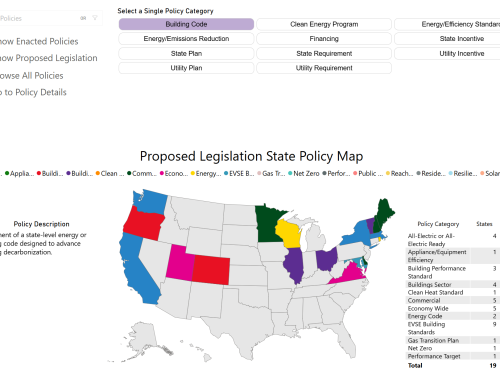
As of the 2020 Residential Energy Consumption Survey, about four million homes have solar generation capacity, amounting to about three percent of residential buildings in the country. The distribution of these homes is dependent on climate conditions and the friendliness of local, state, and utility policies.
The keystone utility policy for distributed solar generation is known as net metering (NEM). Under NEM, a building with installed solar panels will generate energy first for its own consumption before selling excess energy back to the grid. As a result, the building’s occupants benefit from decreased utility bills, paying only the net cost of whatever energy the building pulls from the grid in solar downtimes, minus energy sent back into the grid under sunnier scenarios (aside from other fixed costs that do not vary with consumption). The grid benefits from increased distributed generation capacity from a clean energy source, improving systemwide resiliency.
On its face, NEM appears to be an uncontroversial policy. In fact, almost every state and territory in the country has some sort of active NEM or distributed energy credit, driving variable solar installations across the country (Figure 1). Yet as solar costs have declined, there has been a tension between incentivizing solar adoption and avoiding a perception of throwing taxpayer dollars at a technology that no longer needs help to get off the ground. This has shown up in states from Iowa to South Carolina to West Virginia. Most recently, the policy has come under regulatory fire in California and Puerto Rico.
Figure 1: Percentage of households with solar systems, 2020
Since 2022, the California Public Utilities Commission (CPUC) and the state legislature have chipped away at residential and commercial incentives to install solar panels. In December 2022, the CPUC adopted new rules that reduced payments to new residential solar systems by at least 75 percent beginning in April 2023, but did assign $900 million to incentivize low-income households to adopt solar. These rules contained provisions to encourage homeowners to install battery storage systems alongside their solar panels, a controversial option as lumping the cost of storage systems onto that of installing solar panels may make the overarching system too expensive for many consumers to afford.
Then, in November 2023, the CPUC took on rules effecting multifamily residential buildings and commercial buildings installing new solar systems, reducing payments to these systems by about 80 percent, with demand fluctuation dependent on the season and time of day. Existing NEM rates would persist for consumers in affordable housing programs, however.
Finally, on May 30, the CPUC passed rules for community solar projects, which reorganized the calculation process of the benefits to the grid derived from these systems. In effect, the new formula will reduce payments for both owners of these systems and residents subscribed to them, further disincentivizing solar adoption. These rules will not come into effect until California’s $250 million grant from Solar for All is expended on existing solar incentives. All of the aforementioned new rates realize a net billing system, as opposed to a NEM system.
Some of these policy changes came because of state legislation. AB2316, passed in September 2022, mandated the CPUC “evaluate each customer renewable energy subscription program, as described, to determine if the program meets specified goals, to authorize the termination or modification of a program that does not meet those goals, and to determine whether it would be beneficial to ratepayers to establish a community renewable energy program.” The bill’s author stated that this action resulting in disincentivizing new solar projects, was an unintended result of the bill’s passage.
Lobbying by large utilities is a likely culprit of these rule changes. NEM typically represents new costs for utilities. Depending on the policy and when it was established, a NEM policy may set reimbursement rates for solar panel owners higher than it would cost for utilities to buy from the wholesale market. Yet, thanks to the Public Utility Regulatory Policies Act, utilities must buy solar power from small producers. If there is already a glut of power on the grid, this could represent major losses for the utilities. An ongoing NEM battle in Puerto Rico delineates the political matter of independent solar systems.
This January, the territory passed Act 10, which extends Puerto Rico’s NEM policy through 2031 to continue incentivizing solar adoption. The policy has been working — Puerto Rico’s rooftop solar capacity doubled from 400 MW to 800 MW generated by 117,000 buildings between July 2022 and March 2024. The island’s Financial Oversight and Management Board (FOMB), however, is looking to reverse the law under the claim that it threatens the independence of Puerto Rico’s energy regulators.
The resiliency offered by independent solar systems is invaluable to a grid like Puerto Rico’s, which was obliterated in 2017 by Hurricane Maria and has not recovered. FOMB was created by the federal government in 2016 and has been controversial throughout its existence. This latest action directly contradicts federal efforts to expand cheaper solar installation especially for low-income communities, including the $156 million Puerto Rico received from Solar for All, seemingly working against the public interest of Puerto Ricans.
Change may be coming to California, as SB1374 passed California’s Senate on May 30. The bill attempts to reverse the CPUC rules for multifamily and commercial buildings from November 2023. Yet this bill only resolves one piece of the pricing puzzle in one state. As Solar for All dollars are expended nationwide and utilities attempt to keep their systems profitable, a legislative reckoning for net metering may be around the corner.



